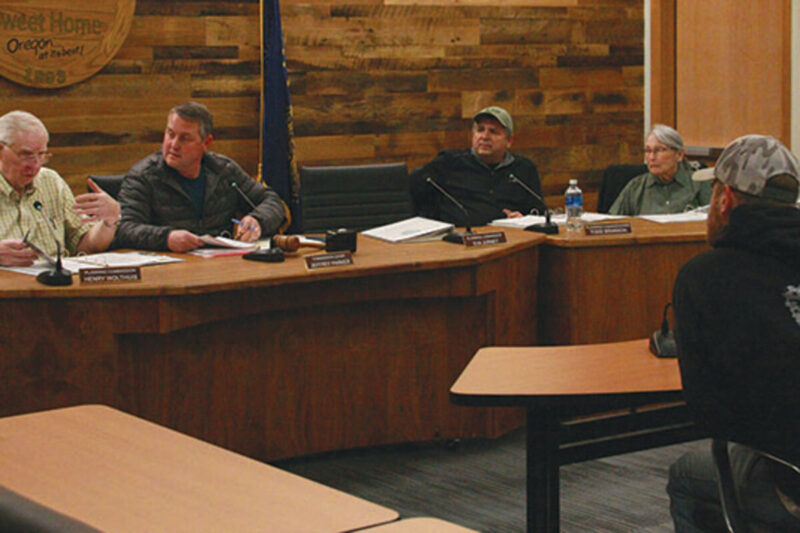Benny Westcott
The Sweet Home Planning Commission on Thursday, April 6, voted 4-2 to recommend that the city council change the zoning of a 5.18-acre property west of Clark Mill Road to allow for the planned construction of an apartment building complex with a large, residents-only fitness center.
Applicant Eric Lund’s proposed change alters the zoning from residential low (R-1) to high density (R-3), bringing the zoning into conformity with the property’s existing comprehensive plan map designation.
Planning Commission Chair Jeffrey Parker, who voted in favor of the change with fellow commissioners Jamie Melcher, Laura Wood and Nancy White, said, “The comprehensive plan map that we have set for the future and the growth of Sweet Home does show this at some point becoming an R-3, so a high-density area, based on its proximity to the highway.”
But Clark Mill Road resident Mark Scott expressed several concerns about the potential development, suggesting single-family dwellings instead.
“When we bought our house next to that property, we were told that that’s what it was zoned for, and that it would not be apartment buildings,” he said. “We were told that the zoning was going to be simply that. We were fine with that.”
He argued that a large parking lot would decrease residents’ well-water supply by not allowing water to seep through the ground, noting that he and two neighbors rely on wells as their primary water source.
He added that there were “virtually no sidewalks” on Clark Mill Road despite it “sitting in the middle of a school zone,” and that there were already traffic issues.
“Literally this morning, I sat for 15 minutes just trying to get out of my driveway,” he said.
“I don’t know what you’re going to do when you start putting in 75 to 100 apartments, and you have that parking condition. Unless the city’s planning to put traffic lights on both Long Street and Highway 20, you’re going to have a major traffic backup right there.”
He also worried about apartment lights spilling onto his property.
“If you guys have a building put up there, I’m going to be sitting for the rest of my life with lights shining in the back of my yard,” he said. “I’m not sure any of you guys would be overly excited to find out that you’re having an apartment building put over your backyard.”
Community and Economic Development Director Blair Larsen replied that a new development would require a lighting plan, with no “light trespass” permitted.
“Any lights that are on the property would have to be directed on the property itself,” he said.
Scott also asked about the apartments’ impact on area property values.
“There’s several properties throughout Sweet Home that are perfect for putting apartment buildings,” he said, “but I don’t think that where you guys are looking at having that right now is an appropriate area, because of the concerns.
“I would ask that you guys consider keeping this more of a single-family dwelling [area], which it was originally zoned to be, and not allow an apartment building to be stuck in the middle of a residential center.”
Commissioners Henry Wolthuis and Todd Branson voted against the zone-change recommendation. Branson, too, worried about traffic.
“The intersection on Highway 20 and Clark Mill is already a nasty intersection,” he said.
In other action:
n The Planning Commission voted 4-1 to allow a variance for a 12-foot rear setback from the back of a proposed home to the back property line of 1907 Willow St. The Sweet Home City Code would typically only allow for a 15-foot setback in the scenario.
Property owner Brian Oakes, of Monroe, who plans to rebuild a house on the property after the previous structure burned down in a fire, applied for the variance because, while the property is zoned medium density (R-2), a category with a minimum lot size of 5,000 square feet, the property is actually only 3,485, a “nonconforming lot” in city terms.
Parker was the one commissioner who voted against granting the variance.
“I think the intentions are great, fixing the neighborhood up, building something new, trying to revitalize the area,” he said. “I get it. I understand it. But at the same time, we’re also battling, historically, the willy-nilly handout of variances.”
Melcher did not vote after connection issues prevented her from attending that part of the meeting virtually.





